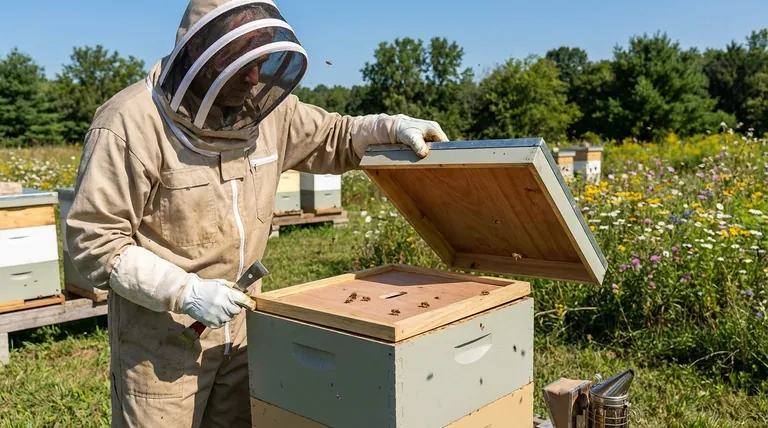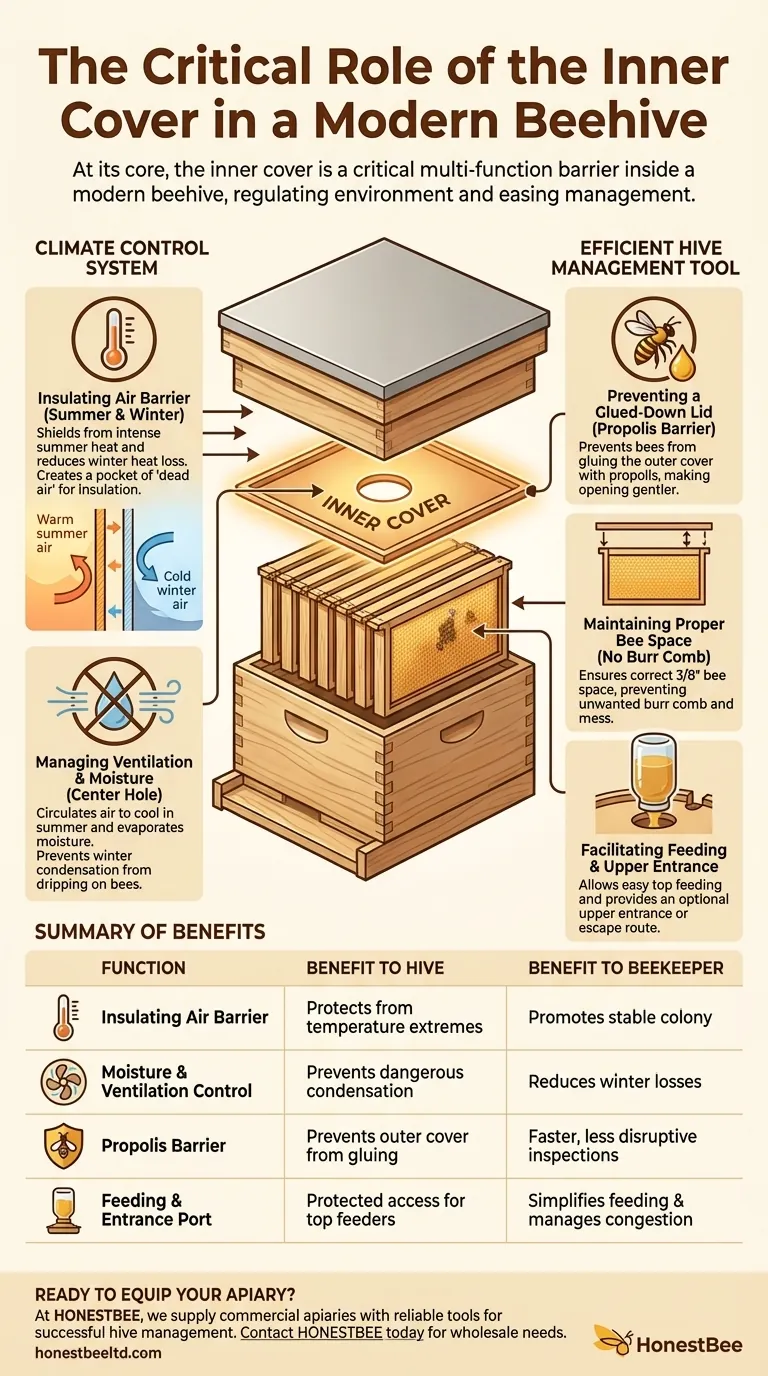At its core, the inner cover is a critical multi-function barrier inside a modern beehive. Positioned directly on top of the uppermost box and beneath the main telescoping outer cover, its primary roles are to create an insulating air space, prevent bees from sealing the hive shut with propolis, and provide the beekeeper with a tool for managing ventilation and feeding.
The inner cover is far more than a simple internal lid; it is an essential interface that regulates the hive's internal environment. It provides climate control and makes hive inspections less disruptive for the bees and easier for the beekeeper.

The Inner Cover as a Climate Control System
A healthy colony must maintain a stable internal environment, and the inner cover is a key component in achieving this. It primarily works by controlling air and moisture.
Creating an Insulating Air Barrier
The space between the inner cover and the outer cover creates a pocket of "dead air." This trapped air acts as a powerful insulator.
In the summer, this barrier shields the colony from the intense, direct heat of the sun hitting the outer cover. In the winter, it helps reduce heat loss, allowing the bees to expend less energy staying warm.
Managing Hive Ventilation
Most inner covers feature a hole in the center. This is not just for feeding; it's a crucial part of the hive's ventilation system.
Bees use this opening to help circulate air, which is essential for cooling the hive in hot weather by evaporating water.
Controlling Winter Moisture
A winter cluster of bees generates significant moisture through respiration. When this warm, moist air rises and hits a cold outer cover, it condenses into water.
The inner cover provides a warmer surface that helps manage this condensation. The insulating air gap keeps the inner cover from getting as cold, reducing the risk of cold water dripping down onto the overwintering bees, which can be fatal.
A Tool for Efficient Hive Management
Beyond environmental control, the inner cover serves several practical functions that make the beekeeper's job significantly easier and less stressful for the colony.
Preventing a Glued-Down Lid
Bees use a sticky resin called propolis to seal cracks and secure parts of their hive. Without an inner cover, they would firmly "glue" the outer cover directly to the top box.
Prying off a propolized outer cover requires significant force, which violently jars the hive and agitates the colony. The inner cover provides a simple, breakable seal that makes opening the hive a much gentler process.
Maintaining Proper Bee Space
Bees instinctively build comb in any space larger than about 3/8 of an inch. The inner cover sits directly on the top bars of the frames, maintaining correct "bee space."
This prevents the colony from building unwanted burr comb inside the lid, which would make a mess and crush bees every time the hive is opened.
Facilitating Feeding
The central hole is perfectly designed to accommodate a top feeder. Typically, a beekeeper can place an inverted jar of sugar syrup directly over the hole.
This allows for easy, protected feeding without having to fully open the hive or expose the feed to robber bees from other colonies.
Providing an Upper Entrance
Many inner covers have a small notch on one of the rim edges. When oriented correctly, this notch creates a small upper entrance for the bees.
This can be useful for reducing congestion at the main bottom entrance during a heavy nectar flow or providing an escape route for moisture during winter.
Understanding the Trade-offs and Variations
While a standard component, the design and use of an inner cover can be adapted to your specific climate and management style.
The "Winter" and "Summer" Positions
The notched rim allows for seasonal adjustment. In summer, you can position the cover with the notch open to provide extra ventilation and an upper entrance.
In winter, you can flip the cover or slide it so the notch is blocked by the outer cover's rim. This closes the upper entrance to conserve heat while still allowing for some moisture to escape through the central hole.
Is an Inner Cover Always Necessary?
In standard Langstroth beekeeping, the inner cover is considered essential for the reasons outlined above. Its benefits in hive health and ease of management are well-established.
While some alternative hive designs or management philosophies might omit it, for the vast majority of beekeepers, its function is indispensable. Skipping it often leads to a propolized, difficult-to-manage hive with greater temperature and moisture stress.
Making the Right Choice for Your Goal
How you use the inner cover depends on your immediate objective.
- If your primary focus is year-round hive health: Use the inner cover to insulate the colony and carefully manage winter moisture by ensuring proper ventilation.
- If your primary focus is easier hive inspections: Always use an inner cover to prevent the outer lid from being glued shut, making your work faster and less disruptive to the bees.
- If your primary focus is reducing hive congestion: Position the inner cover to use the upper entrance notch during a heavy nectar flow.
- If your primary focus is supplemental feeding: Utilize the central hole for a top feeder, which provides direct, protected access for the colony.
By understanding its multiple roles, the inner cover transforms from a simple piece of wood into a powerful tool for successful beekeeping.
Summary Table:
| Function | Benefit to the Hive | Benefit to the Beekeeper |
|---|---|---|
| Insulating Air Barrier | Protects from summer heat and winter cold | Promotes a stronger, more stable colony |
| Moisture & Ventilation Control | Prevents dangerous condensation in winter; cools hive in summer | Reduces winter losses and heat stress |
| Propolis Barrier | Prevents outer cover from being glued shut | Makes hive inspections faster and less disruptive |
| Feeding & Entrance Port | Provides protected access for top feeders and an upper entrance | Simplifies feeding and manages hive congestion |
Ready to equip your apiary with high-quality, durable inner covers and other essential beekeeping supplies?
At HONESTBEE, we supply commercial apiaries and beekeeping equipment distributors with the reliable tools needed for successful hive management. Our wholesale-focused operations ensure you get the best value on equipment designed to support colony health and beekeeper efficiency.
Contact HONESTBEE today to discuss your wholesale needs and discover how our supplies can contribute to the success of your operation.
Visual Guide

Related Products
- Inner Beehive Cover for Beekeeping Bee Hive Inner Cover
- Professional Insulated Winter Hive Wrap for Beekeeping
- Professional Insulated Plastic Bee Hives
- HONESTBEE Professional Long Handled Hive Tool with Precision Cutting Blade
- HONESTBEE Professional Multi-Functional Hive Tool with Ergonomic Wood Handle
People Also Ask
- What is an inner cover in a beehive and what are its features? A Key Tool for Hive Health & Management
- What is the function of an inner cover in a beehive? Essential for Hive Health & Management
- Why might beekeepers use an inner cover under the telescoping outer cover? Simplify Hive Management & Protect Your Colony
- What is the recommended orientation for the rim of an inner cover? Master Hive Ventilation and Insulation
- What is the role of inner covers in insulated beehives? Master Moisture Control for a Healthy Colony



















